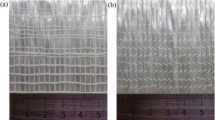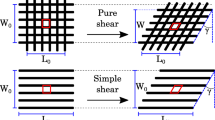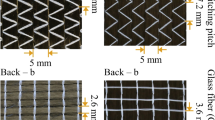Abstract
In-plane shear is considered as the main deformation mechanism during the forming of fabrics on double curved geometries. Non-Crimp Fabrics (NCFs) are more and more used in the industry thanks to their high mechanical performances. The uniaxial bias extension (UBE) test is commonly used for characterizing the in-plane shear behavior of fabrics. However, presence of slippages calls the reliability of this test into question for NCF material. These slippages lead to a macroscopic kinematic which does not respect the fundamental hypotheses of UBE test theory. The variety of NCF architectures is usually pointed while the lack of standardized experimental methods is seldom discussed. The first section of this paper presents a two-way approach to detect slippage on an NCF. This approach is based on two kinematical descriptions of the UBE test. The first one assumes a pure shear behavior whereas the second one assumes a simple shear behavior. These behaviors correspond respectively to the rotation of fibers and to the slippage of fibers from a macroscopic point of view. In the second section, the two-way approach is used to analyze experimental UBE tests. This investigation highlights the influence of the sample width on the deformation mode during a UBE test. More precisely, it is shown that increasing the sample width of NCF specimens improves the UBE test reliability.












Similar content being viewed by others
References
Lebrun G, Bureau MN, Denault J (2003) Evaluation of bias-extension and picture-frame test methods for the measurement of intraply shear properties of PP/glass commingled fabrics. Compos Struct 61(4):341–352
Boisse P, Hamila N, Guzman-Maldonado E, Madeo A, Hivet G, Dell’Isola F (2017) The bias-extension test for the analysis of in-plane shear properties of textile composite reinforcements and prepregs: a review. Int J Mater Form 10(4):473
De Luycker E (2009) Simulation et expérimentation en mise en forme de renforts composites 3D interlocks. Thèse, INSA, Lyon
Bel S (2011) Analyse et simulation de la mise en forme des renforts de composites NCF. Thèse, INSA, Lyon
Launay J, Hivet G, Duong AV, Boisse P (2008) Experimental analysis of the influence of tensions on in plane shear behaviour of woven composite reinforcements. Compos Sci Technol 68(2):506–515
Ferretti M, Madeo A, Dell’Isola F, Boisse P (2014) Modeling the onset of shear boundary layers in fibrous composite reinforcements by second-gradient theory. Z Angew Math Phys 65(3):587–612
Harrison P, Alvarez MF, Anderson D (2016) Towards comprehensive characterisation and modelling of the forming and Wrikling mechanics of engineering fabrics. Int J Solids Struct 154:2–18
Harrison P (2016) Modelling the forming mechanics of engineering fabrics using a mutually constrained pantographic beam and membrane mesh. Compos Part A Appl Sci Manuf 81:145–157
Harrison P, Clifford MJ, Long AC (2004) Shear characterisation of viscous woven textile composites: a comparison between picture frame and bias extension experiments. Compos Sci Technol 64(10-11):1453–1465
Harrison P, Taylor E, Alsayednoor J (2018) Improving the accuracy of the uniaxial bias extension test on engineering fabrics using a simple wrinkle mitigation technique. Compos Part A Appl Sci Manuf 108:53–61
Harrison P, Tan MK, Long AC (2005) “Kinematics of intra-ply slip in textile composites during Bias extension tests,” In 8th ESAFORM conf
Härtel F, Böhler P, Middendorf P (2014) An integral mesoscopic material characterization approach. Key Eng Mater 611–612:280–291
P. Middendorf and C. Metzner, “Aerospace applications of non-crimp fabric composites,” in Non-crimp fabric composites: Manufacturing, properties and applications, S. V. Lomov, Ed. Woodhead Publishers, Cambridge 2011, pp. 441–448
Bardl G, Nocke A, Cherif C, Pooch M, Schulze M, Heuer H, Schiller M, Kupke R, Klein M (2016) Automated detection of yarn orientation in 3D-draped carbon fiber fabrics and preforms from eddy current data. Compos Part B Eng 96(June):312–324
Bardl G, Nocke A, Hübner M, Gereke T, Pooch M, Schulze M, Heuer H, Schiller M, Kupke R, Klein M, Cherif C (2018) Analysis of the 3D draping behavior of carbon fiber non-crimp fabrics with eddy current technique. Compos Part B Eng 132:49–60
Krieger H, Gries T, Stapleton SE (2017) Shear and drape behavior of non-crimp fabrics based on stitching geometry. Int J Mater Form:1–13
Krieger H, Gries T, Stapleton SE (2017) Design of Tailored non-Crimp Fabrics Based on stitching geometry. Appl Compos Mater
Bel S, Hamila N, Boisse P, Dumont F (2012) Finite element model for NCF composite reinforcement preforming : importance of inter-ply sliding. Compos Part A Appl Sci Manuf 43(12):2269–2277
Schirmaier FJ, Weidenmann A, Kärger L, Henning F (2016) Characterization of the draping behaviour of unidirectional non-crimp fabrics (UD-NCF). Compos Part A Appl Sci Manuf 80:28–38
Böhler P, Härtel F, Middendorf P (2013) Identification of forming limits for unidirectional carbon textiles in reality and mesoscopic simulation. Key Eng Mater 554–557:423–432
Mallach A, Härtel F, Heieck F, Fuhr J-P, Middendorf P, Gude M (2016) Experimental comparison of a macroscopic draping simulation for dry non-crimp fabric preforming on a complex geometry by means of optical measurement. J Compos Mater:1–13
Chen S, Endruweit A, Harper LT, Warrior NA (2015) Inter-ply stitching optimisation of highly drapeable multi-ply preforms. Compos Part A Appl Sci Manuf 71:144–156
Deghboudj S, Satha H (2014) Determination of the in-plane shear rigidity modulus of a carbon non-crimp fabric from bias-extension data test. J Compos Mater 48(22):2729–2736
Colin D, Bel S, Hans T, Hartmann M (2018) “On the inter-stitch interaction in biaxial non-crimp fabrics,” In Esaform 2018
Chen S, McGregor OPL, Harper LT, Endruweit A, Warrior NA (2016) Defect formation during preforming of a bi-axial non-crimp fabric with a pillar stitch pattern. Compos Part A Appl Sci Manuf 91:156–167
Deghboudj S, Boukhedena W, Satha H (2018) Experimental and finite element analysis of in-plane shear properties of a carbon non-crimp fabrics at macroscopic scale. J Compos Mater 52(2):235–244
Lomov SV, Barburski M, Stoilova T, Verpoest I, Akkerman R, Loendersloot R, Thije RHW (2005) Carbon composites based on multiaxial multiply stitched preforms. Part 3: biaxial tension, picture frame and compression tests of the preforms. Compos Part A Appl Sci Manuf 36(9):1188–1206
Creech G (2006) “Mesoscopic finite element modelling of non-crimp fabrics for drape and failure analyses,” Thèse, Cranfield University
Creech G, Pickett AK (2006) Meso-modelling of non-crimp fabric composites for coupled drape and failure analysis. J Mater Sci 41(20):6725–6736
Bel S, Hamila N, Boisse P (2011) “Characterisation of non-crimp fabric deformation mechanisms during preforming,” In 18th international conference on composite materials
Härtel F, Harrison P (2014) Evaluation of normalisation methods for uniaxial Bias extension tests on engineering fabrics. Compos Part A Appl Sci Manuf 37:61–69
Bel S, Boisse P, Dumont F (2012) Analyses of the deformation mechanisms of non-crimp fabric composite reinforcements during preforming. Appl Compos Mater 19(3–4):513–528
Pourtier J, Duchamp B, Kowalski M, Legrand X, Wang P, Soulat D (2018) “Analysis of defaults occured during bias extension tests on non-crimp fabrics,” In ECCM-18, no. June, pp. 1–7
Harrison P, Yu W-R, Long AC (2011) “Modelling the deformability of biaxial non-crimp fabric composites,” In Non-crimp fabric composites : Manufacturing, properties and applications, S. V. Lomov, Ed. Woodhead Publishers, pp. 161–182
Schirmaier FJ, Dörr D, Henning F, Kärger L (2017) A macroscopic approach to simulate the forming behaviour of stitched unidirectional non-crimp fabrics (UD-NCF). Compos Part A Appl Sci Manuf 102:322–335
Leutz D (2015) “Forming simulation of AFP materials layups material characterization simulation and validation,” Thèse, Technische Universität München
Moreira DC, Nunes LCS (2013) Comparison of simple and pure shear for an incompressible isotropic hyperelastic material under large deformation. Polym Test 32(2):240–248
J. Cao et al. (2004) “A cooperative benchmark effort on testing of woven composites,” in In proceedings of the 7th ESAFORM conference on material forming, pp. 305–308
Zhao X, Liu G, Gong M, Song J, Zhao Y, Du S (2018) Effect of tackification on in-plane shear behaviours of biaxial woven fabrics in bias extension test: experiments and finite element modeling. Compos Sci Technol 159:33–41
Pourtier J, Duchamp B, Kowalski M, Legrand X, Wang P, Soulat D (2018) Bias extension test on a bi-axial non-crimp fabric powdered with a non-reactive binder system. AIP Conf Proc 1960:8–11
Acknowledgments
The authors want to acknowledge the members of the Fast FORM project consortium (Arkema, Chomarat, Compose Group, Coriolis, ESI Group, Faurecia, Hexion, Hutchinson, Institut de Soudure Group, Innovation Plasturgie Composites, Owens Corning, Pinnette Emidecau Industries, PSA Group, Renault, Sise), the IRT M2P and the GEMTEX laboratory for their support.
Funding
This research received the funding from the PIA (Programme Investissements d’Avenir) and the industrial consortium (Arkema, Chomarat, Compose Group, Coriolis, ESI Group, Faurecia, Hexion, Hutchinson, Institut de Soudure, Innovation Plasturgie Composites, Owens Corning, Pinnette Emidecau Industries, PSA Group, Renault, SISE).
Author information
Authors and Affiliations
Corresponding author
Ethics declarations
Conflicts of interest
The authors declare no conflict of interest.
Additional information
Publisher’s note
Springer Nature remains neutral with regard to jurisdictional claims in published maps and institutional affiliations.
Rights and permissions
About this article
Cite this article
Pourtier, J., Duchamp, B., Kowalski, M. et al. Two-way approach for deformation analysis of non-crimp fabrics in uniaxial bias extension tests based on pure and simple shear assumption. Int J Mater Form 12, 995–1008 (2019). https://doi.org/10.1007/s12289-019-01481-8
Received:
Accepted:
Published:
Issue Date:
DOI: https://doi.org/10.1007/s12289-019-01481-8




